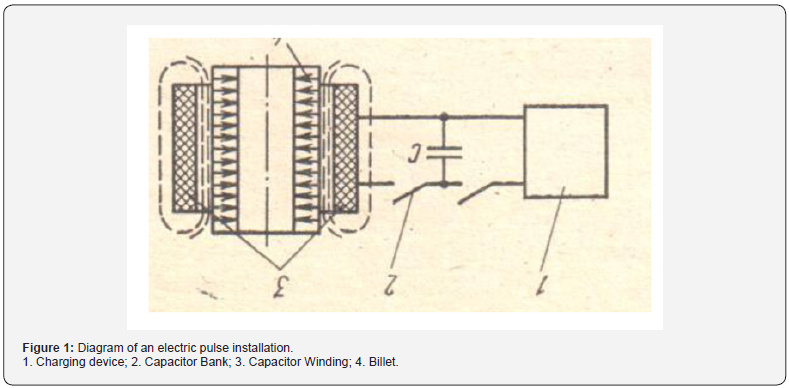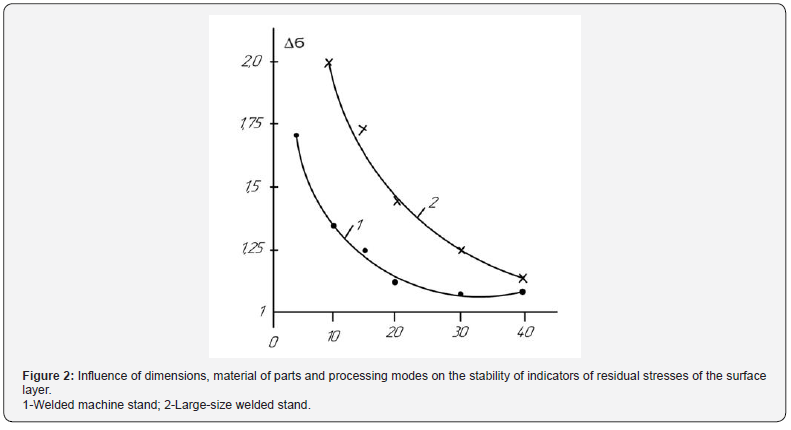Magnetic Pulse Stabilization of the Geometry of Prefabricated Products
Vladislav Smolentsev*
Voronezh State Technical University, 14 Moskovsky Ave, Voronezh, 394026 Russia
Submission:November 05, 2020;Published:December 10, 2020
*Corresponding Author:Vladislav S, Voronezh State Technical University, 14 Moskovsky Ave, Voronezh, 394026 Russia
How to cite this article: Vladislav S. Magnetic Pulse Stabilization of the Geometry of Prefabricated Products. Civil Eng Res J. 2020; 11(2): 555806.10.19080/CERJ.2020.10.555806
Annotation
The results of research on the stabilization of the geometric dimensions of large hull blocks obtained using welded joints are presented. The connection between the change in the construction geometry and the modes of strengthening by vibration effects caused by controlled electromagnetic pulses with the imposition of an electric field is shown. The ways of controlling multiple mechanical impulses to strengthen the surface layer and equalize the internal stresses of the mating parts are shown, which allows reducing errors after welding. Developed methodology for designing a combined technological process for pulse stabilization of the geometry of workpieces.
Keywords:Magnetic Pulse processing; Vibration; Error; Technology; Modes
Introduction
In [1,2] it is shown that one of the ways to stabilize the size of cast and welded workpieces is pulse combined electromagnetic processing, which does not require the creation of thermal sections and is successfully used for processing large-sized parts in small and medium-sized businesses .It is known from [3,4] that controlled pulse effects can reduce the level of surface stresses and equalize their level to a value that excludes warping of products during processing and operation [5].
Scope of use of the Magnetopulse Method of Processing
Magnetic pulse surface treatment has a lot in common with vibration shock hardening [1], but it can significantly simplify the technological process, since it is performed without the use of mechanical vibrators, the installation of which causes great difficulties when installing on complex-contoured surfaces. In addition, this method allows for local processing of product sections, which significantly expands the area of manufacturing large-sized parts, since many machine-building enterprises of small and medium-sized businesses do not have their own thermal sites for metal annealing, and performing such operations on the side is associated with additional transport costs, lengthening the technological cycle, and the need to re-equip their own production with control tools and personnel of performers.
Magnetic pulse stabilization of the workpiece geometry.
The essence of the magnetopulse method is sufficiently fully disclosed in [3] and shown in (Figure 1) 1. charging device; 2. capacitor Bank; 3. capacitor Winding;4. Billet. The charger 1 (Figure 1) contains a rectifier of the current supplied to the capacitor Bank 2.in which, at the beginning of the discharge, energy is accumulated sufficient to de-form the workpiece 4, but not exceeding the value of the beginning of the plastic flow of the workpiece material. Next, it is placed on the windings of the exciter 3, where a changing magnetic field is formed, causing the appearance of electromagnetic forces (shown by the arrows in the Figure.1), the control of which allows you to create a vibration of the workpiece and ensure the redistribution of residual stresses in it in the areas adjacent to the welding sites.
The principal difference between the technology of magnetoimpulse stabilization of stresses in the surface layer of the workpiece from a similar process of their formation [3,4] is the use of a control criterion ,according to which the limit value of the electromagnetic force must be lower than the yield strength of the workpiece material 4 (RISU-nok1).Since part of the pulse energy is converted to heat, which affects the deformation of the workpiece, the criterion record uses a coefficient that reduces the calculated value of this force by 15-20%, which should be taken into account when calculating technological modes magnetic pulse process. The efficiency of using magnetic pulse processing to stabilize the properties of workpieces depends on the level of manufacturability [5] and the quality of surface preparation in the same way [6].
Methodology for Designing the Process of Magnetic Pulse Processing
The initial data for the design of the technological process of magnetic pulse processing, which provides stabilization of internal stresses of large-sized welded structures, is information about the geometry, properties of the material of the workpieces, methods of their production, processing modes, the degree of development of the vibration process, availability of personnel and equipment of the production. The effectiveness of the developed technological process is evaluated by the stability of obtaining the required accuracy and performance characteristics of products at all stages of the CALS technology. With regard to the processing necessary to justify the choice of parameters considered in the study of the mechanism of magnetic-pulse processing scheme of an agent according to [3,4], to identify areas of detail which require vibrostability voltages. This should be reflected in the technical documentation, where recommendations should be included installation instructions sources of vibration on the workpiece.

When working out the manufacturability should be taken into account:
1. The possibility of direct force action on the workpiece of the vibration exciter. Violation of this condition can cause shock loads on the tool and its destruction.
2. Take into account the limitations that ensure the safety of the workpiece during processing, for which use the results on the rigidity of the workpiece under the action of pulses obtained at the stage of development of a new process, and periodically monitor the state of technological discipline in the serial production of products.
3. Use modes adapted to the final indicators for the specified accuracy of the workpieces. Thus, the experience of vibration stabilization of welded structures has shown that the process can be performed in several transitions: at the first stage, which takes about half of the processing time, the greatest calculated vibration amplitude of the treated area is applied. At the next transitions, the mode is gradually softened. Here, the control is performed by the processing time and the value of the amplitude of vibrations of the workpiece section.
The stage of work on the equipment includes the preparation of installation bases, where standard elastic machine supports are used for this purpose, which are selected taking into account the mass and geometry of the parts to be processed. The number of supports (at least 3) depends on the size and shape of the support surface of the workpiece. When working out the processing modes, adjust the frequency of vibrations, preferably until a stable resonant amplitude value appears. The range from 50 to 100 Hz is used as the base for tuning, which does not cause technological difficulties.
Control of the processing mode can be performed by changing the current supplied to the vibrator. However, with an increase in the size of the part, this indicator decreases and when changing less than 12-15 %, it becomes not a reliable indicator for control. Therefore, the process is controlled by the processing time that is set during setup, taking 60 minutes as the initial value for large workpieces and reducing this figure during debugging mode with an interval of 5-10 minutes. Acceptance control of processing quality is performed based on the results of measuring the size of the part at the base points after stabilization of residual stresses. The operation is usually performed selectively on the first processed part from the batch. on coordinate measuring machines.
Figure 2 shows the results of measuring residual stresses in the process of magnetic pulse processing, where the stability of their value is estimated by the average value of the unevenness of residual stresses (Δσ ) at the welding site in the workpiece from the time (τ ) of magnetic pulse processing. The index 1 shows the non-uniformity of residual stresses in the welded structure of the milling machine stand made of steel 3 with dimensions of 100 X 600 X 950 mm with the calculated placement of 4 vibration exciters. The workpiece was placed on a table with a stable gap. Index 2 (Figure 2) shows information about a steel frame with a length of 2200 mm after arc welding.


Analysis of materials in Figure2 shows that depending on the shape, dimensions, position of welds, the main para-metertime management of the process of magnetic-pulse treatment – should work with real samples and re-results of comprehensive measurements to clarify the processing time increases with increase in size of the parts. In this case, for a smaller part, the minimum processing time is about 20 minutes, and for a larger frame-more than 40 minutes.
Figure 3 shows the operating modes of stabilization of the rack shown in Figure 2 under index 1. For a time of τ =20 min (Figure 2), the vibration frequency (f) should be maintained in the range of 55-65 Hz and preferably in a resonant mode. For the same processing duration, the vibration amplitude (A) at the processing site is set according to Figure 3. Measurements of the processed parts (Figure 3) showed that stable dimensions can be obtained for metal-cutting machines with a welded stand at an optimal (preferably resonant) pulse frequency and oscillation amplitude of 0.5-0.7 mm. If the resonant frequency exceeds the recommended range, then set the frequency required for this and specify the modes according to the calculated dependencies and graphs of the type shown in (Figures 2 & 3).
Conclusion
The study of the mechanism of magneto-pulse stabilization of large-sized welded parts and the experience of operating mobile installations using the proposed technology have shown the feasibility of using the process in flexible structures used in industrial enterprises of small and medium-sized businesses and in the repair of technological equipment in the absence of funds for heat treatment of large-sized parts.
References
- Babichev AP, BabichevIA (1998) Fundamentals of vibration technology. Rostov on Don: DSTU publishing Center p: 624.
- Borodavko VIet al. (2017) Combined pulsed thermomechanical effects with the use of an electromagnetic Field and a deforming Tool in. Collector Tr. Vibro-wave processes in the technology of processing parts of high-tech Products. Rostov on Don: DSTU p: 240.
- SmolentsevVP(1983) Electrophysical and electrochemical methods of material processing.In 2 vol. T. 2Under the Editorship SmolentsevVPM:Higher School p: 208.
- Rakoshits GS (1984) Electro-Pulse Stamping. M:Higher School p: 192.
- Safonov SV, SmolentsevVP, MandrykinV (2019) Methodology of working out manufacturability when launching into production of high-tech products of aerospace equipment. Science-Intensive technologies in mechanical engineering7 (97): 30-34.
- Panichev EV, SmolentsevVP (2019)Surface Preparation for applying a heat-resistant coaning. Strengthening technologies and coatings15(11): 517-522.






























